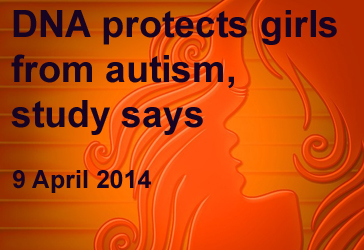Check out other stories from the Latest News
Are Females Protected Against Autism by Their DNA?
By Eric Larsen, Ph.D. on April 9, 2014

Background: One of the hallmarks of Autism Spectrum Disorder (ASD) is its increased prevalence in males, with an estimated male-to-female ratio of four-to-one. Scientists hypothesize that this gender bias may be the result of the “female protective model.” According to this model, a greater extent of genetic damage is required to overcome an inherent protective mechanism in females. Subsequently, ASD is found more often in males, who require less genetic damage to trigger ASD onset.
What’s new: A recent report in the American Journal of Human Genetics analyzes the genetic variation present in male and female individuals with ASD. The authors report that females with ASD possess a greater number of damaging genetic variants compared to males on the spectrum. Moreover, damaging genetic variations are inherited more often from mothers, rather than fathers. Given that males and females have a different set of sex chromosomes (females have two X chromosomes, and males have an X an Y chromosome), the authors questioned if genetic changes to the X chromosome might put males at higher risk for ASD. They concluded, however, that genetic variation in the X chromosome made very little contribution to ASD.
Why it’s important: This study strengthens the case for a “female protective model” in ASD. Future research will likely seek to understand the underlying basis for this protective effect in females. Furthermore, the findings of this study may have potential implications in the interpretation of genetic screening studies in ASD cases.
Help me understand :
| Source(s) : |
| Tweet |

